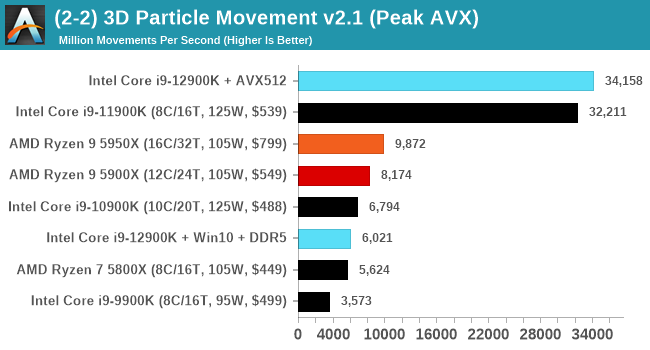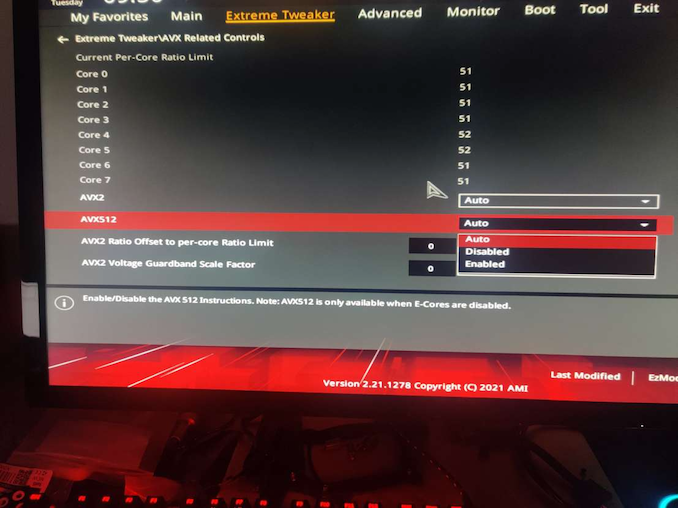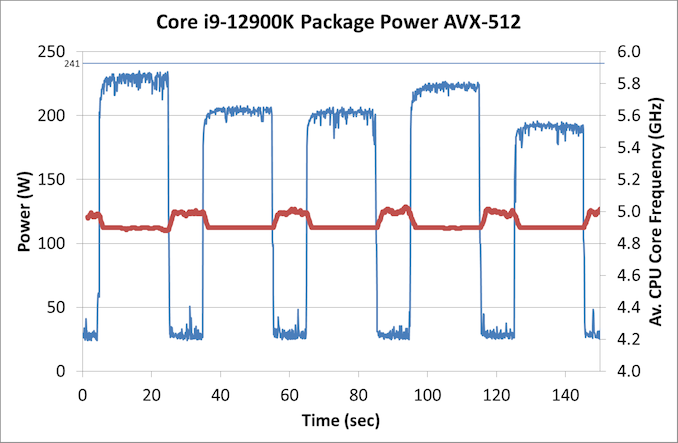The Intel 12th Gen Core i9-12900K Review: Hybrid Performance Brings Hybrid Complexity
by Dr. Ian Cutress & Andrei Frumusanu on November 4, 2021 9:00 AM ESTIntel Disabled AVX-512, but Not Really
One of the more interesting disclosures about Alder Lake earlier this year is that the processor would not have Intel’s latest 512-bit vector extensions, AVX-512, despite the company making a big song and dance about how it was working with software developers to optimize for it, why it was in their laptop chips, and how no transistor should be left behind. One of the issues was that the processor, inside the silicon, actually did have the AVX-512 unit there. We were told as part of the extra Architecture Day Q&A that it would be fused off, and the plan was for all Alder Lake CPUs to have it fused off.
Part of the issue of AVX-512 support on Alder Lake was that only the P-cores have the feature in the design, and the E-cores do not. One of the downsides of most operating system design is that when a new program starts, there’s no way to accurately determine which core it will be placed on, or if the code will take a path that includes AVX-512. So if, naively, AVX-512 code was run on a processor that did not understand it, like an E-core, it would cause a critical error, which could cause the system to crash. Experts in the area have pointed out that technically the chip could be designed to catch the error and hand off the thread to the right core, but Intel hasn’t done this here as it adds complexity. By disabling AVX-512 in Alder Lake, it means that both the P-cores and the E-cores have a unified common instruction set, and they can both run all software supported on either.
There was a thought that if Intel were to release a version of Alder Lake with P-cores only, or if a system had all the E-cores disabled, there might be an option to have AVX-512. Intel shot down that concept almost immediately, saying very succinctly that no Alder Lake CPU would support AVX-512.
Nonetheless, we test to see if it is actually fused off.
On my first system, the MSI motherboard, I could easily disable the E-cores. That was no problem, just adjust the BIOS to zero E-cores. However this wasn’t sufficient, as AVX-512 was still clearly not detected.
On a second system, an ASUS motherboard, there was some funny option in the BIOS.
Well I’ll be a monkey’s uncle. There’s an option, right there, front and centre for AVX-512. So we disable the E-cores and enable this option. We have AVX-512 support.
For those that have some insight into AVX-512 might be aware that there are a couple of dozen different versions/add-ons of AVX-512. We confirmed that the P-cores in Alder Lake have:
- AVX512-F / F_X64
- AVX512-DQ / DQ_X64
- AVX512-CD
- AVX512-BW / BW_X64
- AVX512-VL / VLBW / VLDQ / VL_IFMA / VL_VBMI / VL_VNNI
- AVX512_VNNI
- AVX512_VBMI / VBMI2
- AVX512_IFMA
- AVX512_BITALG
- AVX512_VAES
- AVX512_VPCLMULQDQ
- AVX512_GFNI
- AVX512_BF16
- AVX512_VP2INTERSECT
- AVX512_FP16
This is, essentially, the full Sapphire Rapids AVX-512 support. That makes sense, given that this is the same core that’s meant to be in Sapphire Rapids (albeit with cache changes). The core also supports dual AVX-512 ports, as we’re detecting a throughput of 2 per cycle on 512-bit add/subtracts.
For performance, I’m using our trusty 3DPMAVX benchmark here, and compared to the previous generation Rocket Lake (which did have AVX-512), the score increases by a few percent in a scenario which isn’t DRAM limited.

Now back in that Rocket Lake review, we noted that the highest power consumption observed for the chip was during AVX-512 operation. At that time, our testing showcased a big +50W jump between AVX2 and AVX-512 workloads. This time around however, Intel has managed to adjust the power requirements for AVX-512, and in our testing they were very reasonable:
In this graph, we’re showing each of the 3DPM algorithms running for 20 seconds, then idling for 10 seconds. Each one has a different intensity of AVX-512, hence why the power is up and down. IN each instance, the CPU used an all-core turbo frequency of 4.9 GHz, in line with non-AVX code, and our peak power observed is actually 233 W, well below the 241 W rated for processor turbo.
Why?
So the question then refocuses back on Intel. Why was AVX-512 support for Alder Lake dropped, and why were we told that it is fused off, when clearly it isn’t?
Based on a variety of conversations with individuals I won’t name, it appears that the plan to have AVX-512 in Alder Lake was there from the beginning. It was working on early silicon, even as far as ES1/ES2 silicon, and was enabled in the firmware. Then for whatever reason, someone decided to remove that support from Intel’s Plan of Record (POR, the features list of the product).
By removing it from the POR, this means that the feature did not have to be validated for retail, which partly speeds up the binning and testing/validation process. As far as I understand it, the engineers working on the feature were livid. While all their hard work would be put to use on Sapphire Rapids, it still meant that Alder Lake would drop the feature and those that wanted to prepare for Alder Lake would have to remain on simulated support. Not only that, as we’ve seen since Architecture Day, it’s been a bit of a marketing headache. Whoever initiated that dropped support clearly didn’t think of how that messaging was going to down, or how they were going to spin it into a positive. For the record, removing support isn’t a positive, especially given how much hullaballoo it seems to have caused.
We’ve done some extensive research on what Intel has done in order to ‘disable’ AVX-512. It looks like that in the base firmware that Intel creates, there is an option to enable/disable the unit, as there probably is for a lot of other features. Intel then hands this base firmware to the vendors and they adjust it how they wish. As far as we understand, when the decision to drop AVX-512 from the POR was made, the option to enable/disable AVX-512 was obfuscated in the base firmware. The idea is that the motherboard vendors wouldn’t be able to change the option unless they specifically knew how to – the standard hook to change that option was gone.
However, some motherboard vendors have figured it out. In our discoveries, we have learned that this works on ASUS, GIGABYTE, and ASRock motherboards, however MSI motherboards do not have this option. It’s worth noting that all the motherboard vendors likely designed all of their boards on the premise that AVX-512 and its high current draw needs would be there, so when Intel cut it, it meant perhaps that some boards were over-engineered with a higher cost than needed. I bet a few weren’t happy.
Update: MSI reached out to me and have said they will have this feature in BIOS versions 1.11 and above. Some boards already have the BIOS available, the rest will follow shortly.
But AVX-512 is enabled, and we are now in a state of limbo on this. Clearly the unit isn’t fused off, it’s just been hidden. Some engineers are annoyed, but other smart engineers at the motherboard vendors figured it out. So what does Intel do from here?
First, Intel could put the hammer down and execute a scorched earth policy. Completely strip out the firmware for AVX-512, and dictate that future BIOS/UEFI releases on all motherboards going forward cannot have this option, lest the motherboard manufacturer face some sort of wrath / decrease in marketing discretionary funds / support. Any future CPUs coming out of the factory would actually have the unit fused out, rather than simply turned off.
Second, Intel could lift the lid, acknowledge that someone made an error, and state that they’re prepared to properly support it in future consumer chips with proper validation when in a P-core only mode. This includes the upcoming P-core only chips next year.
Third, treat it like overclocking. It is what it is, your mileage may vary, no guarantee of performance consistency, and any errata generated will not be fixed in future revisions.
As I’ve mentioned, apparently this decision didn’t go down to well. I’m still trying to find the name of the person/people who made this decision, and get their side of the story as to technically why this decision was made. We were told that ‘No Transistor Left Behind’, except these ones in that person’s mind, clearly.












474 Comments
View All Comments
mode_13h - Saturday, November 6, 2021 - link
> A competent CEO wouldn’t have allowed this situation to occur.And you'd know this because... ?
> This is an outstanding example of how the claim that only engineers
> make good CEOs for tech companies is suspect.
You're making way to much of this.
I don't know who says "only engineers make good CEOs for tech companies". That's an absolutist statement I doubt anyone reasonable and with suitable expertise to make such proclamations ever would. There are plenty of examples where engineers in the CEO's chair have functioned poorly, but also many where they've done well. The balance of that particular assessment doesn't hang on Gelsinger, and especially not on this one issue.
Also, your liberal arts degree is showing. I'm not casting any aspersions on liberal arts, but when you jump to attack engineers for stepping outside their box, it does look like you've got a big chip on your shoulder.
Oxford Guy - Sunday, November 7, 2021 - link
‘Also, your liberal arts degree is showing. I'm not casting any aspersions on liberal arts’Your assumption about my degrees is due to the fact that I understand leadership and integrity?
mode_13h - Sunday, November 7, 2021 - link
> Your assumption about my degrees is due to the fact that I understand leadership and integrity?Yes, exactly. It's exactly your grasp of leadership and integrity that I credit for your attack on engineers stepping outside their box. Such a keen observation. /s
(and that's how you "sarcasm", on the Internet.)
kwohlt - Sunday, November 7, 2021 - link
I'm not sure how familiar you are with CPU design, but Alder Lake was taped in before Gelsinger took over. The design was finalized, and there was no changing it without massive delays. For the miniscule amount of the market that insists on AVX-512 for the consumer line, it can be implemented after disabling E Cores. AVX-512 just doesn't work on Gracemont, so you can't have both Gracemont and AVX-512 simultaneously. CPU designs take 4 years. You'll see the true impact of Gelsingers leadership in a few years.SystemsBuilder - Saturday, November 6, 2021 - link
MS and intel tried to sync their plans to launch Windows 11 and Alderlake at (roughly) the same time. intel might have been rushed to lock their POR to hit Windows 11 launch. There may even be a contractual relationship between Intel and Microsoft to make sure Windows 11 runs best on Intel's Alder Lake - Intel pay MS to optimize the scheduler for Alder lake and in return Intel has to lock the Alder Lake POR maybe even up to a year go... because MS was not going to move the Windows 11 launch date.Speculation from my side of course, but I don't think I am too far off...
Oxford Guy - Saturday, November 6, 2021 - link
Such excuses don’t work.The current situation is inexcusable.
SystemsBuilder - Saturday, November 6, 2021 - link
yes it is inexcusable BUT the Pat might not have had a choice because he does not control Microsoft.Satya N. would just tell Pat we have a contract - fulfill it!
We are not going to delay Windows 11 it's shipping October 2021 so we will stick with the POR you gave us in 2020!
Satya is running a $2.52 trillion market cap company current #1 in the world
Pat is running a $206.58 billion market cap company
so guess who's calling the shots.
Pat says "ok... but maybe we can enable it for the 22H1 version of win 11, please Satya help me out here..."
in the end I think MS will do the right thing and get it to work but it might get delayed a bit.
Again, my speculation. And again, I don't think I am far off...
Oxford Guy - Saturday, November 6, 2021 - link
The solution was not to create this incompetent partial ‘have faith’ AVX-512 situation. Faith is for religion, not tech products.The solution was to be clear and consistent. For instance, if Windows is the problem then that should have been made clear. Gelsinger should have said MS doesn’t yet have its software at full compatibility with Alder Lake. He should have said it will be officially supported when Windows is ready for it.
He should have had a software utility for power users to disable the small cores in order to have AVX-512 support, or at least a BIOS option — mandated for all Alder Lake boards — that disables them as an option for those who need AVX-512.
The current situation cannot be blamed on Microsoft. Intel has the ability to be clear, consistent, and competent about its products.
Claiming that Intel isn’t a large enough entity to tell the truth also doesn’t pass muster. Even if it’s inconvenient for Microsoft to be exposed for releasing Windows 11 prematurely and even if it’s inconvenient for Intel to be exposed for releasing Alder Lake prematurely — saving face isn’t an adequate excuse for creating a situation this untenable.
Consumers deserve non-broken products that aren’t sold via smoke and mirrors tactics.
SystemsBuilder - Saturday, November 6, 2021 - link
a couple of points:- yes it would have been better to communicate to the market that AVX-512 will be enabled with 22H1 (or what ever - speculating) of windows 11 but what about making it work with windows 10 and when... i mean the whole situation it's a cluster. I do agree that the current marketing decision under Pat's what and how to communicate to the market what is happening with Alder Lake and AVX-512 and Windows 10/11 could have been handled much, much better. the way they have done it is a disaster. it's like is it in or out i mean wtf. is it strategic or not. This market communicating, related decisions and what every new agreements they need to strike with Microsoft to make the whole thing make sense is on Pat - firmly!
- i am not blaming Microsoft at all. I am mostly blaming the old marketing and the old CEO - pure incompetence for getting Intel into this situation in the first place. I don't have all the insights into Intel's internals but from an outside perspective it looks like that to me.
Oxford Guy - Saturday, November 6, 2021 - link
Gelsinger’s responsibility is to lead, not blame previous leadership.Alder Lake came out on his watch. The AVX-512 debacle, communications and lack of mandated minimum specs (official partial support for the lifetime of AL in 100% of AL boards via BIOS switch to disable small cores) happened to while he was CEO.
The lie about fusing off happened under his leadership.
We have been lied to and spacetime can’t be warped to erase the stain on his tenure.